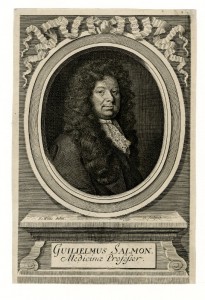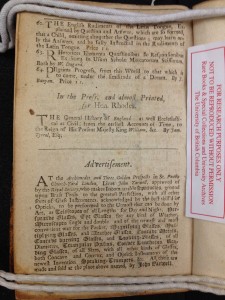Due to a general lack of material available on William Salmon, the information on this page relies heavily on research published in the Oxford Dictionary of National Biography, as well as work done by a handful of other scholars. Bibliographical information is available on my sources page.
The flamboyant persona behind The Family Dictionary (as well as an impressive array of other titles ranging in subject from medical and herbal remedies to religion, the fine arts, and astrology) seems to have had a suitably eccentric life. Born on June 2nd, 1644, Salmon’s childhood and early adulthood was adventurous. An apprentice to a mountebank, Salmon travelled around with his master making speeches and performing tricks to entertain audiences and extol the virtues of both his master and his wares. He also wrote texts that explained how the medicines were to be used. Much of his training is attributed to these formative experiences.
As evidenced by publishing information in Synopsis medicinae, or, A compendium of astrological, Galenical & chymical physick in 1671, William Salmon had begun a medical practice outside the Smithfield gate of the St. Bartholomew’s hospital around this time. As was common practice among “irregular types of practitioners” (as his entry in the Oxford Dictionary of National Biography puts it), his patients were those who had been denied the services of the hospital proper. Though it is difficult to tell from the limited amount of information available on Salmon’s life how successful or skillful of a physician he was, it has been suggested that much of the material in his works was directly sourced from a sizeable personal collection of medical and other literature, and that there is little evidence to suggest that he contributed to the field of medicine in any original way.
Though the move towards the professionalization of medicine is generally attributed to the nineteenth century, there was debate in Salmon’s time over disciplinary boundaries, in which he was a passionate participant. The Royal College of Physicians had a strong interest in controlling the field and practice of medical knowledge (which, at this time, included places like apothecaries as well as irregular practitioners like Salmon) in order to attach a certain level of credibility to their academy and prevent “impostors practicing outside the bounds of the college” (DNB). Salmon protested against this in writing, publishing texts that directly debated the issue as well as those that implicitly confronted the type of knowledge being authorized, such as reference books on herbal remedies and a work titled Collectanea medica: the Country Physician in 1703.
Salmon’s published persona played into this debate as well. Throughout his works he refers to himself with titles such as “Professor of Physick”, “M.D.”, and “Medicinae Professor”, reinforcing his disciplinary authority in print. The fairly successful print runs of his books, many of which went through two or three editions, seems to evidence the fact that his books were popular, if not imbued with originality or the proper disciplinary clout. His cunning use of advertisement (discussed in greater detail here) seems to have been a necessary aspect of his somewhat dubious trade: he made money selling books, but also advice, remedies, and perhaps even advertising space in his texts; on the last page of the second edition of The Family Dictionary, there is a lengthy advertisement for the “Incomparable Spectacles” of John Yarwell.
The limited amount of information available on William Salmon paints a portrait of someone who was certainly eccentric, but also well rounded and active in many different arenas of both knowledge and interest. A member of a religious sect, a prolific writer and publisher, and a persuasive master of all things marketing, Salmon’s life and writings are a veritable treasure trove of idiosyncratic seventeenth and eighteenth century tidbits and avenues for further investigation into a colourful past.
learn more about:
the form | the book market | the recipes | sources
or, go home

